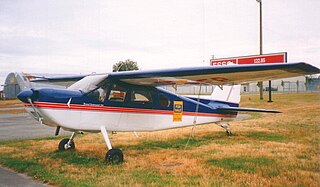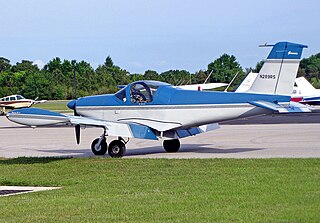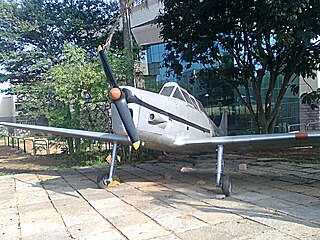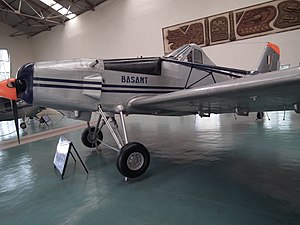
The IMCO CallAir A-9 is a small agricultural aircraft that first flew in 1962, a development of the company's previous successful crop-dusters. It is typical of aircraft of its type - a single-seat aircraft with a low wing incorporating spraying gear.

The Piper PA-36 Pawnee Brave is a 1970s American single-engined, low-wing, propeller-driven agricultural plane built by Piper Aircraft.

The Found Centennial 100 is a Canadian six-seat cabin monoplane produced by Found Brothers Aviation.

The Call-Air Model A is an American two- to three-seat utility aircraft designed by the Call brothers and built by the Call Aircraft Company, later developed into a successful line of agricultural aircraft.

The Mudry CAP 20 is a French family of aerobatic competition single seater monoplanes.

The MBB 223 Flamingo was a light aircraft developed in West Germany in the 1960s in response to a competition for a standard trainer for the country's aeroclubs. Designed by SIAT, it was a conventional low-wing monoplane with fixed tricycle undercarriage. The cockpit was enclosed by a large bubble canopy. SIAT had not undertaken much production of the type before the firm was acquired by MBB in 1970. Eventually, the new owners transferred production to CASA in Spain.

The DINFIA IA 45 Querandi was a 1950s Argentine twin-engined light transport aircraft built by the DINFIA.

The Evangel 4500 was a 1960s American twin-engined light passenger/cargo monoplane built by the Evangel Aircraft Corporation.

The Piper Aerostar is an American twin-engined propeller-driven executive or light transport aircraft, designed by Ted R. Smith. It was originally built by Ted Smith Aircraft Company, which after 1978 became part of the Piper Aircraft Corporation.

The Pazmany PL-1 Laminar and Pazmany PL-2 are American two-seat trainer and personal light aircraft designed by Ladislao Pazmany to be marketed as a homebuilt aircraft by his company Pazmany Aircraft Corporation. The aircraft was built under license in Taiwan as the AIDC PL-1B Cheinshou. It was later followed by an improved version the PL-2. The SLAF Aircraft Engineering Wing developed a modified variant of the PL-2 in 1977, which was never used operationally.

The HAL HT-2 is an Indian two-seat primary trainer designed and built by Hindustan Aeronautics Limited (HAL). The HT-2 was the first company design to enter production in 1953 for the Indian Air Force and Navy, where it replaced the de Havilland Tiger Moth. The HT-2 is a low-wing cantilever monoplane with a fixed tailwheel landing gear. Powered by a 155 hp (116 kW) Cirrus Major III piston engine, the aircraft has enclosed tandem cockpits with dual controls. Apart from military use, the aircraft was also used by Indian flying schools.

The Lake Buccaneer is an American four-seat, light amphibious aircraft derived from the Colonial C-2 Skimmer, itself a development of the three-seat Colonial C-1 Skimmer.

The SIAI-Marchetti S.210 was a 1970s Italian twin-engined cabin-monoplane designed and built by SIAI-Marchetti as a development of the single-engined SIAI-Marchetti S.205.
The Neiva Campeiro is a Brazilian two-seat utility monoplane built by Indústria Aeronáutica Neiva for the Brazilian Air Force. The Campeiro was based on the earlier Neiva Paulistinha 56 with a re-designed structure and powered by a 150 hp (112 kW) Avco Lycoming O-320-A piston engine. The Camperiro was a braced high-wing monoplane with a fixed tailwheel landing gear. Twenty aircraft were built for the Brazilian Air Force as the L-7 Campeiro and were used for liaison, observation, rescue and training.

The Utva-65 Privrednik (Merchant) is a Yugoslav civil aircraft designed and used for agricultural work.
The Hongdu N-5,, originally known as the Nanchang N-5, is a Chinese agricultural aircraft. First flown in 1989, and entering into production in 1992, the N-5 is a single-engined low-wing monoplane, and is available in versions powered by a piston engine or a turboprop.
The Terzi T30 Katana is an Italian single-seat competition aerobatic monoplane designed by the Milanese aeronautical engineer Pietro Terzi. Terzi built a limited series with his firm Terzi Aerodyne based in Milan, Italy.
The Eshelman FW-5 was a 1940s American experimental cabin monoplane designed and built at Dundalk, Maryland by the Cheston L. Eshelman Company.
The FLUGWAG Bremen ESS 641 was a 1970s German glider-towing monoplane designed and built by the Flugwissenschaftliche Arbeitsgemeinschaft Bremen research organisation.

The IAR 27 was a 1930s Romanian two-seat low-wing monoplane primary trainer designed and built by Industria Aeronautică Română.















